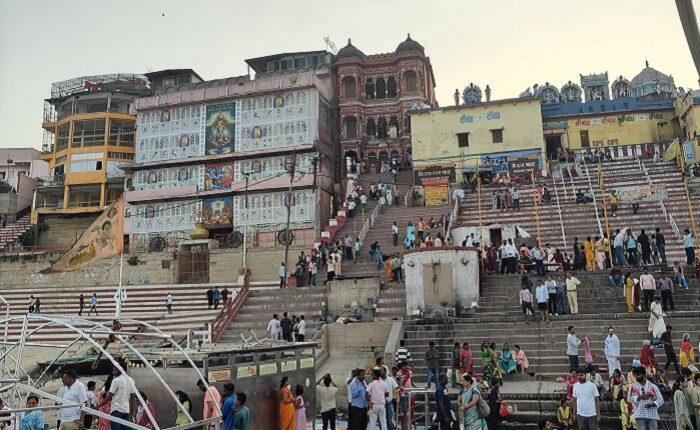Radhika Dhakal
Kathmandu- Varanasi, Also known as Kashi or Banaras, Varanasi is a mythical and historic city situated on the banks of the Ganges River in the Indian state of Uttar Pradesh. It is regarded as a unique symbol of human civilization, a place where religion, philosophy, music, art, literature, tourism, and commerce have thrived together for millennia. For followers of Hinduism, this city is the “Avimukta Kshetra” a place created by Lord Shiva himself and never to be forsaken. However, Varanasi is not just a sacred site for Hindus; it is also a profoundly important pilgrimage destination for Buddhists and Jains.
A Historical Tapestry: A City Older Than Time
Varanasi is one of the oldest continuously inhabited cities in the world. Its origins are traced back nearly 3,000 years, although Hindu tradition holds that the city is 5,000 years old, founded by Lord Shiva. References to Varanasi are found in ancient scriptures like the Skanda Purana, Mahabharata, Ramayana, and the Rigveda. The history of the city is deeply intertwined with the influential role of the Kashi Naresh (the King of Kashi), who has been instrumental in preserving its cultural and religious identity.
The famous Chinese pilgrim Xuanzang, who visited Varanasi in 635 CE, described it as a bustling center of religious and educational activities. Despite the upheavals of Mughal, Maratha, and British rule, the city has never lost its fundamental identity.
A Nexus of Faith: The Spiritual Heart of India
Varanasi is one of the Saptapuri the seven sacred cities in Hinduism believed to grant moksha (liberation). The Ganges River, worshipped as a goddess, is the spiritual epicenter of the city. Along its banks stretch 84 ghats (steps leading to the river), with Dashashwamedh Ghat, Manikarnika Ghat (the main cremation ghat), and Assi Ghat being the most famous.
The Kashi Vishwanath Temple, one of the twelve Jyotirlingas of Lord Shiva, is considered the most sacred temple in Varanasi. Additionally, sites like the Sankat Mochan Hanuman Temple, Durga Temple, and Tulsi Manas Mandir solidify Varanasi’s status as a holy city.
For Buddhists, Varanasi holds immense significance as it is near Sarnath, where Gautama Buddha delivered his first sermon after attaining enlightenment. Sarnath is home to the Dhamek Stupa, the ruins of ancient monasteries, and temples from various Buddhist sects, making the region a vital Buddhist pilgrimage site.
The Cradle of Culture: Music, Literature, and Art
It would not be an overstatement to call Varanasi the cultural heart of India. It is the birthplace of the Banaras Gharana of Hindustani classical music. Legendary musicians such as Pandit Ravi Shankar, Ustad Bismillah Khan, Girija Devi, and Pandit Hariprasad Chaurasia were either born here or made it their home.
In literature, Varanasi has gifted India with gems like Munshi Premchand, Jaishankar Prasad, Acharya Ramchandra Shukla, Kabir, Ravidas, Vallabhacharya, and Tulsidas. Notably, Tulsidas composed the epic “Ramcharitmanas,” one of the most beloved texts in Hinduism, in this very city. The local dialect, Bhojpuri, spoken by the residents, further enlivens its cultural vibrancy.
A Beacon of Knowledge and Learning
Varanasi has always been a center for education and philosophy. It is home to one of India’s premier educational institutions, Banaras Hindu University (BHU), founded by Pandit Madan Mohan Malaviya in 1916. The university has made profound contributions to fields such as Sanskrit, philosophy, Ayurveda, arts, literature, and science.
Furthermore, institutions like Sampurnanand Sanskrit Vishwavidyalaya, Mahatma Gandhi Kashi Vidyapith, and the Central Institute of Higher Tibetan Studies have further enriched Varanasi’s academic landscape.
A Magnet for Pilgrims and Tourists
Varanasi attracts millions of pilgrims and tourists every year. The sight of the grand Ganga Aarti at Dashashwamedh Ghat, the devotees bathing in the holy river, and the fragrant labyrinth of narrow alleys filled with offerings and flowers provide a deeply spiritual experience for visitors.
Key attractions include the Kashi Vishwanath Temple, Assi Ghat, Manikarnika Ghat, Bharat Mata Mandir, Sarnath, Ramnagar Fort, the bustling old city lanes, workshops for copper and brassware, and centers for Banarasi sari weaving. Famous festivals like Mahashivratri, Ganga Mahotsav, Bharat Milap, and Dhrupad Mela significantly boost cultural and religious tourism.
The Economic Fabric: From Banarasi Saris to Tourism
Varanasi’s economy is founded on traditional industries, trade, and tourism. The world-famous Banarasi sari, known for its intricate brocades of gold and silver thread, fine silk, and artistic craftsmanship, is a major export.
The nearby carpet industry of Bhadohi, traditional handicrafts, glass bangles, copperware, perfumes, and other artisanal products also contribute to the economic activity. Moreover, the tourism sector including hotels, transportation, guide services, and shops selling religious items creates substantial employment. The Lal Bahadur Shastri International Airport, along with robust rail and road networks, connects the city to all major parts of India.
Navigating the Future: Tradition Meets Modernity
In recent times, Varanasi has been striving to embrace modernity while preserving its religious and traditional core. The city’s outskirts are undergoing planned development, with the government actively pursuing initiatives like the Smart City project and green infrastructure.
However, challenges remain. While religious sentiment is strong, maintaining communal harmony and preserving ancient heritage are ongoing tasks. Issues such as the Gyanvapi Mosque dispute, environmental pollution (particularly of the Ganges), and overcrowding necessitate long-term, sustainable planning.
Varanasi is a city that offers an experience touching both the soul and the body. It is not merely a religious center but also a cradle of culture, a source of knowledge, a tourist destination, and a hub of commerce. Varanasi exemplifies how tradition and modernity, spirituality and trade, music and literature, and education and tourism can coexist and thrive in one vibrant place.
(An article by Radhika Dhakal, based on her conversations with locals and priests at Kashi Ghats during her visit to Banaras.)













Comments are closed.